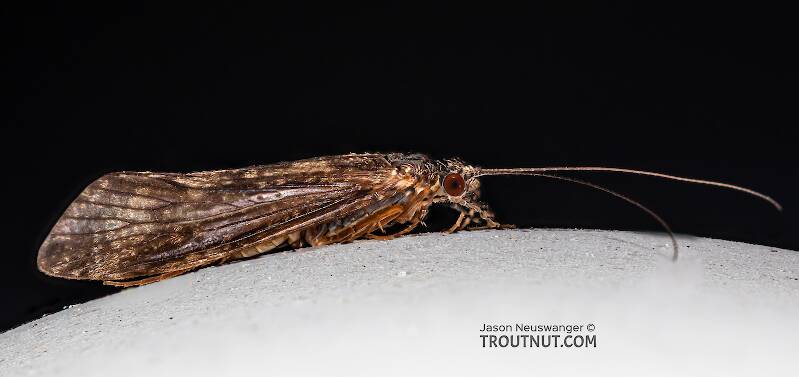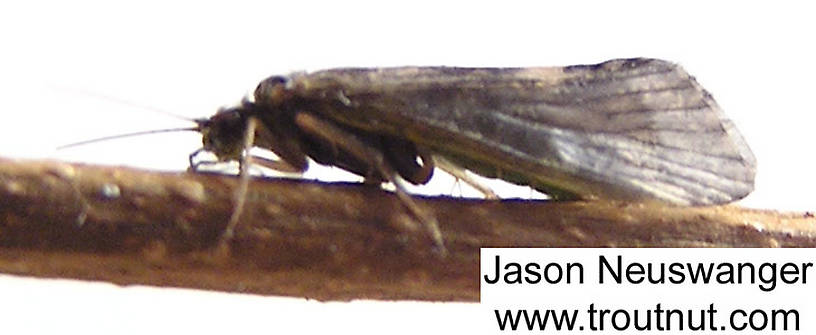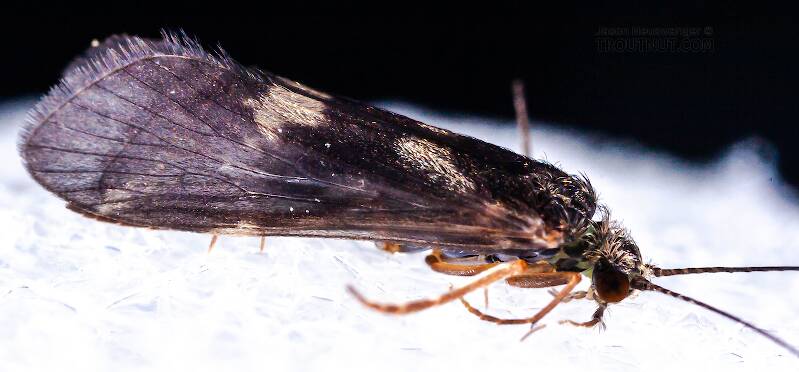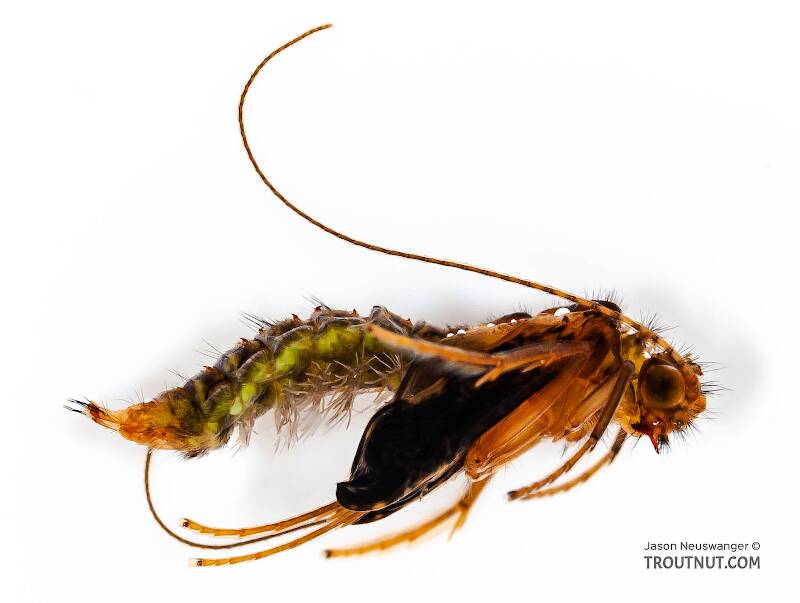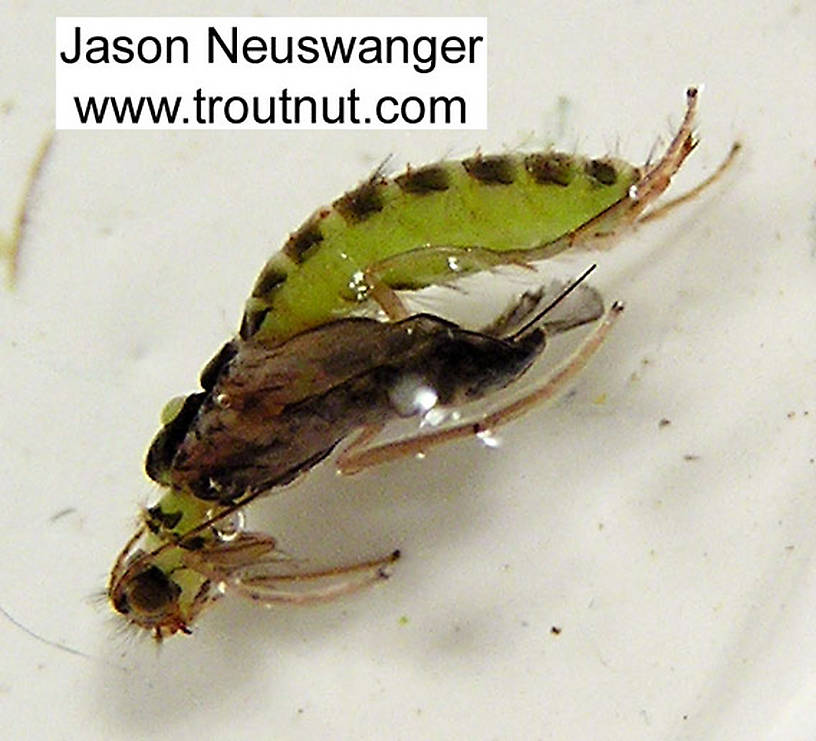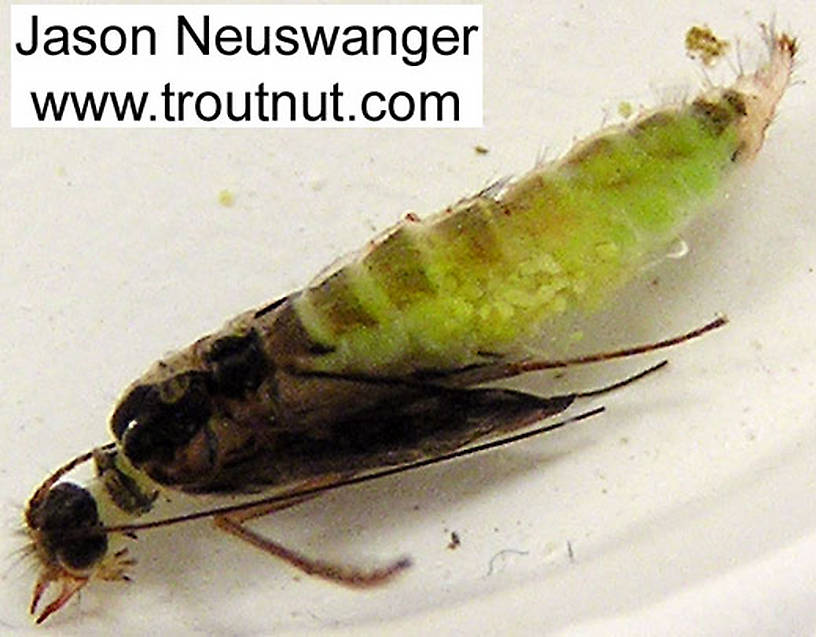
Blue-winged Olives
Baetis
Tiny Baetis mayflies are perhaps the most commonly encountered and imitated by anglers on all American trout streams due to their great abundance, widespread distribution, and trout-friendly emergence habits.
Featured on the forum

Troutnut is a project started in 2003 by salmonid ecologist Jason "Troutnut" Neuswanger to help anglers and
fly tyers unabashedly embrace the entomological side of the sport. Learn more about Troutnut or
support the project for an enhanced experience here.
Caddisfly Genus Cheumatopsyche (Little Sister Sedges)
To generalize broadly, Cheumatopsyche is found lower in the watershed than the similar genera Hydropsyche and Ceratopsyche. It is also smaller, but there is wide variation in size and color between the species. See the family Hydropsychidae page for life cycle details common to these genera.
The most important trout stream species are Cheumatopsyche campyla and Cheumatopsyche pettiti.
The most important trout stream species are Cheumatopsyche campyla and Cheumatopsyche pettiti.
Where & when
In 1233 records from GBIF, adults of this genus have mostly been collected during June (28%), July (22%), May (17%), August (15%), April (7%), and September (7%).
In 444 records from GBIF, this genus has been collected at elevations ranging from 10 to 9186 ft, with an average (median) of 2690 ft.
Genus Range
Specimens of the Caddisfly Genus Cheumatopsyche
1 Male Adult
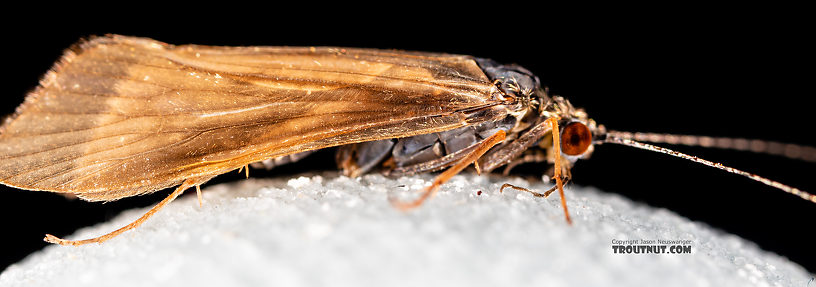
I didn't identify this one directly, but I eventually identified one of several I collected from the same swarms that appeared to be of the same species. (I lost track of which specimen was which in storage.) The microscope pictures come from one of these specimen, not necessarily the same specimen as the DSLR pictures. They key to Cheumatopsyche, and the hind wing venation that separates them from Hydropsyche is pretty clear in the attached picture as well as another specimen I checked under the scope.
This specimen was one of tens of thousands we saw on a July 1st evening on the Madison, beginning with big swarms around every vehicle and tree at the Eight Mile Ford access point and continuing all up and down the river bank. We somehow didn't catch any trout, perhaps because they were stuffed with pupae from when these things emerged. Or maybe we just weren't fishing well. Either way, this one represents a major hatch there.
I somehow forgot to photograph this important specimen against the hooks size chart, but fortunately I preserved a few. The body length is about 6 mm, and total length from head to wingtip is 9 mm.
This specimen was one of tens of thousands we saw on a July 1st evening on the Madison, beginning with big swarms around every vehicle and tree at the Eight Mile Ford access point and continuing all up and down the river bank. We somehow didn't catch any trout, perhaps because they were stuffed with pupae from when these things emerged. Or maybe we just weren't fishing well. Either way, this one represents a major hatch there.
I somehow forgot to photograph this important specimen against the hooks size chart, but fortunately I preserved a few. The body length is about 6 mm, and total length from head to wingtip is 9 mm.
2 Female Adults
1 Adult
3 Pupae
Start a Discussion of Cheumatopsyche
References
- LaFontaine, Gary. 1981. Caddisflies. The Lyons Press.
- Swisher, Doug and Carl Richards. 2000. Selective Trout. The Lyons Press.
Caddisfly Genus Cheumatopsyche (Little Sister Sedges)
Taxonomy
Species in Cheumatopsyche
Cheumatopsyche campyla
0
0
Cheumatopsyche etrona
0
0
Cheumatopsyche gracilis
0
0
Cheumatopsyche harwoodi
0
0
Cheumatopsyche lasia
0
0
Cheumatopsyche pasella
0
0
Cheumatopsyche pettitiCaddisflies
0
0
Cheumatopsyche sordida
0
0
Cheumatopsyche speciosa
0
0
Species in Cheumatopsyche: Cheumatopsyche campyla, Cheumatopsyche etrona, Cheumatopsyche gracilis, Cheumatopsyche harwoodi, Cheumatopsyche lasia, Cheumatopsyche pasella, Cheumatopsyche pettiti, Cheumatopsyche sordida, Cheumatopsyche speciosa
35 species (Cheumatopsyche analis, Cheumatopsyche aphanta, Cheumatopsyche arizonensis, Cheumatopsyche bibbensis, Cheumatopsyche burksi, Cheumatopsyche cahaba, Cheumatopsyche comis, Cheumatopsyche edista, Cheumatopsyche ela, Cheumatopsyche enonis, Cheumatopsyche flinti, Cheumatopsyche gelita, Cheumatopsyche geora, Cheumatopsyche gordonae, Cheumatopsyche gyra, Cheumatopsyche halima, Cheumatopsyche helma, Cheumatopsyche kinlockensis, Cheumatopsyche logani, Cheumatopsyche mickeli, Cheumatopsyche minuscula, Cheumatopsyche mollala, Cheumatopsyche morsei, Cheumatopsyche oxa, Cheumatopsyche parentum, Cheumatopsyche petersi, Cheumatopsyche pinaca, Cheumatopsyche pinula, Cheumatopsyche richardsoni, Cheumatopsyche rossi, Cheumatopsyche smithi, Cheumatopsyche vannotei, Cheumatopsyche virginica, Cheumatopsyche wabasha, and Cheumatopsyche wrighti) aren't included.



